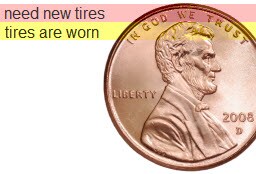
Not sure how to tell if your tires need to be replaced? Try the penny tire tread test to check the depth of your tire tread. It’s a simple, accurate test that anyone can perform on their own and we’ve got instructions on how it’s done below.
Quick Stats
- According to the National Highway Traffic Safety Administration (NHTSA) there are over 11,000 tire-related accidents every year.
- When the tread on tires is less than 2/32 of an inch, the tires should be replaced right away.
- The term “rib” refers to the raised portion of the tire that forms dynamic patterns. Your tires tread is composed of numerous ribs.
- Both underinflated and overinflated tires increase the likelihood of accidents.
- Extreme heat increases the likelihood of tire blowouts, especially with worn or bald tires.
- According to Popular Mechanics, “Underinflation is the easiest way to kill a tire. After all, air is what allows a tire to carry the weight of a vehicle and its cargo.”
Performing the Penny Tire Tread Check
As you may have just seen in our Quick Stats, extreme heat increases the likelihood of blowouts and the chances of this happening are further heightened when drivers use extremely worn or bald tires. So, considering our insane summer temperatures, the penny tire tread check is something that all commuters in the Phoenix area should know. It’s as easy as 1-2-3 and will give you a quick way to see if your tires need to be replaced or not. See steps below.

ONE
Place a penny head-side down into a groove between the tire tread. Do this in several locations.
TWO
If you can see the very top of Lincoln’s head, where the pink bar starts or anything beyond that point, your tires need to be replaced immediately.
THREE
If your tire tread falls in the yellow area, you’re safe to drive on your tires, but they are worn so keep an eye on them over the coming months.
If your tires need to be replaced, Van Buick GMC offers low, cut-rate prices on new tires in Scottsdale.
Schedule an appointment online and make sure to check out current service specials.